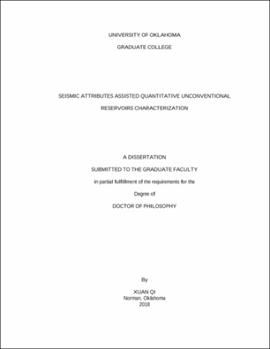| dc.description.abstract | Unconventional reservoirs cover a wide range of hydrocarbon-bearing formations and reservoir types that generally do not produce economic rates of hydrocarbons without stimulation. The focus of this dissertation is to develop and calibrate workflows to aid in the characterization of the highly heterogeneous Mississippi Limestone reservoir play of northern Oklahoma. Because natural fractures and faults are the primary pathways for hydrocarbon migration and production in many reservoirs, naturally fractured reservoirs represent a significant percentage of oil and gas reservoirs throughout the world. In 2012, unconventional shale gas productions were accounting for 34% of the total natural gas production in the U.S. (0.68 trillion m3). Because of their complexity and commercial significance, naturally fractured reservoirs have been extensively studied showing that the in-situ stress field, lithology, formation thickness, structural setting and other geological factors all play a role. The understanding of the magnitude, timing, and distribution of these controlling factors could lead to an improvement in the characterization of fractures in reservoirs. Although, the geomechanical history of the rocks is elusive and often speculative, one can infer the magnitude and orientation of paleostresses and thereby hypothesize the degree of fracturing given current structure. Reservoir structure are mapped using petrophysical logs and seismic techniques where seismic attributes such as coherence and curvature are commonly used to map deformation in the subsurface. This dissertation introduces a new edge-detecting seismic attribute, aberrancy that quantitatively estimates the orientation and magnitude of poorly resolved faults as well as flexures in the subsurface. The rate of penetration (ROP) measures drilling speed, which is indicative of the overall time and in general, the cost of the drilling operation process. ROP depends on many engineering factors; however, if these parameters are held constant, ROP is a function of the geology. This dissertation is the first study that links ROP to seismic data and seismic-related attributes using proximal support vector machine. By using this workflow, we anticipate that this process can help better predict a budget or even reduce the cost of drilling when an ROP assessment is made in conjunction with reservoir quality and characteristics. Due to the complexity of fracture characterization, fracture prediction is more commonly the product of comprehensive integration of software, data, and specialize measurements specific to unconventional reservoirs. To calibrate volumetric aberrancy. I integrate seismic attributes and borehole image logs as the input to neural network. The findings on the use of volumetric aberrancy as an aid to structural interpretation and quantitative fracture prediction. | en_US |
